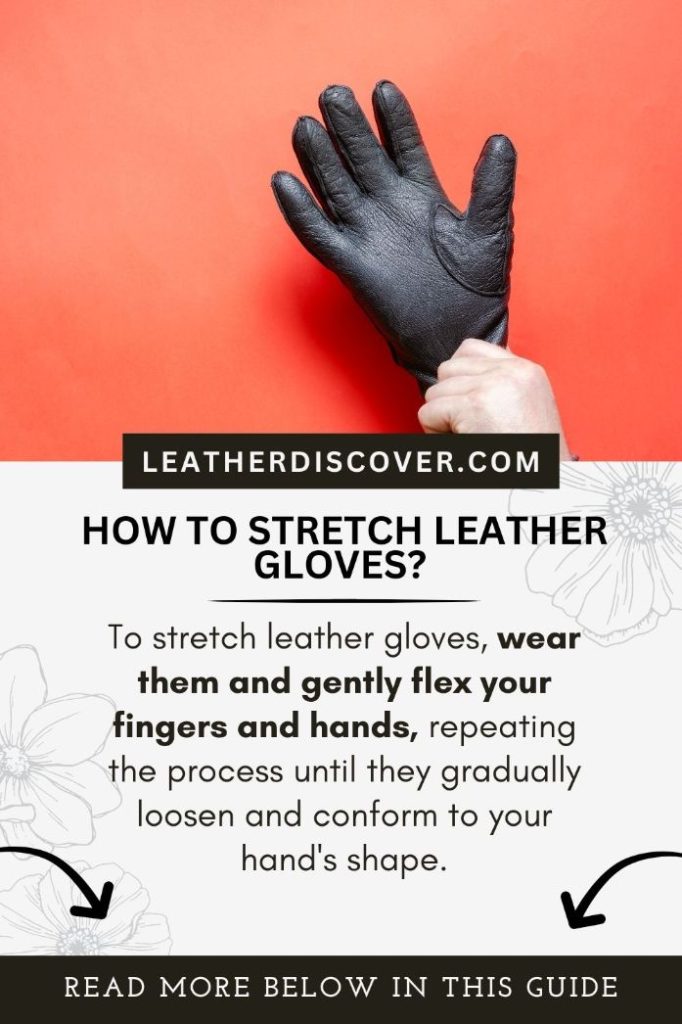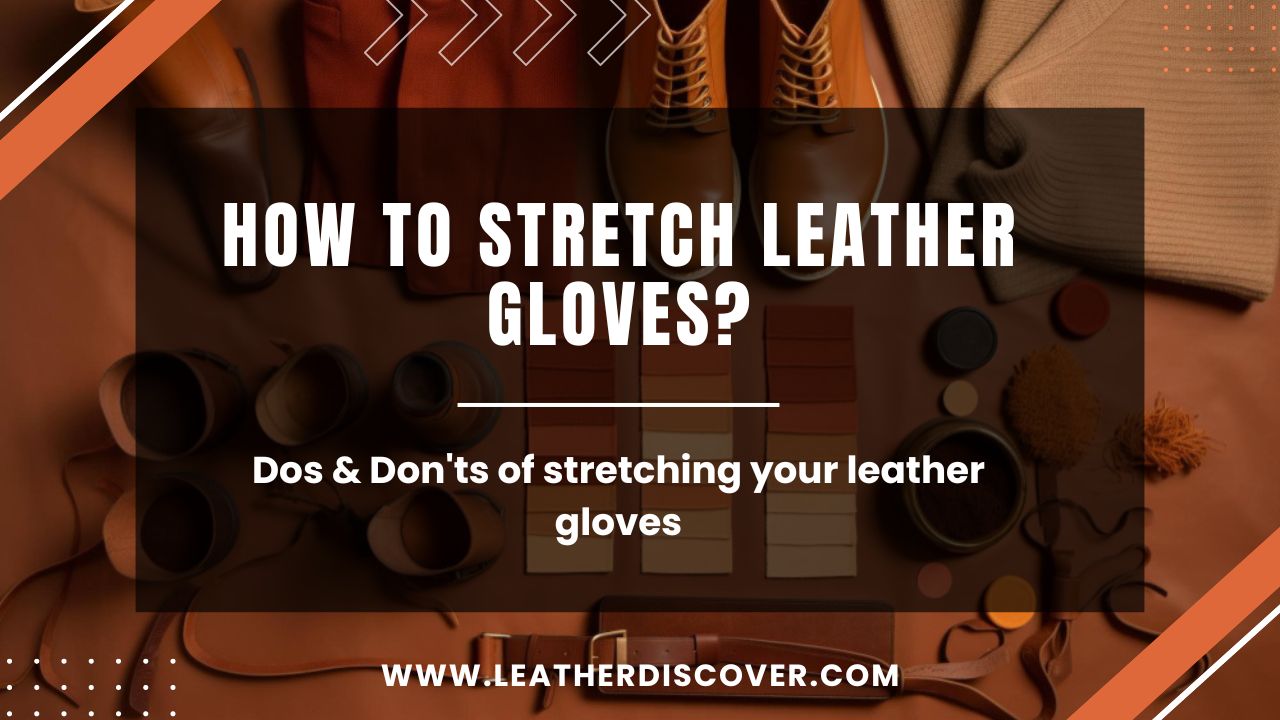Ever found yourself with a beautiful pair of leather gloves that are just too tight? Frustrating, right?
Tight gloves can be uncomfortable and restrict your movement.
I’ve been there too—eager to wear my new gloves, only to find they were a bit snug. It’s a common issue, but luckily, there’s a way to fix it without damaging your gloves.
In this guide, I’ll cover everything you need to know about stretching leather gloves.
I’ll discuss the key factors to keep in mind before you start, step–by–step instructions on how to stretch them, and the dos and don’ts to ensure you get the perfect fit.
Plus, I’ll talk about the consequences of wearing gloves that are too small.
Let’s make sure your gloves fit comfortably and look great!
[toc]

How to Stretch Leather Gloves?
When it comes to stretching leather gloves, preparation is key. Start by gathering your materials: you’ll need rubbing alcohol, a spray bottle, a soft cloth, and some gloves, of course. Personally, I’ve found that using rubbing alcohol mixed with water in a spray bottle works best for this process. It’s gentle on the leather but effective in helping to relax the fibers for stretching.
Step 1: Applying the Stretching Solution
First, mix equal parts rubbing alcohol and water in your spray bottle. Give it a good shake to ensure it’s thoroughly mixed. Then, lightly spray the inside of the gloves with this solution. You want the leather to be slightly damp but not soaked. This step is crucial because it allows the alcohol to penetrate the leather fibers, making them more pliable for stretching.
Step 2: Gentle Massaging and Stretching
Once the gloves are damp, gently massage the leather with your hands. Focus on areas where you feel the gloves are tightest or need the most stretching. This part can be a bit therapeutic—I often take my time here, working the leather slowly to avoid damaging it. Remember, leather is resilient but also delicate, so a gentle touch goes a long way.
Step 3:Wearing and Forming
After massaging, it’s time to wear the gloves. Put them on and flex your fingers and hands to help stretch the leather. This step allows the gloves to mold to your hand’s shape naturally. Personally, I find it helpful to wear them for about an hour or so around the house while doing light activities—it helps the gloves conform to my hand comfortably without overstretching.
Step 4: Air Dry and Evaluate
Once you’ve worn the gloves for a while, take them off and let them air dry naturally. Avoid using direct heat sources like hairdryers or heaters, as they can damage the leather. After they’ve dried, evaluate the fit. If they still feel a bit tight in certain areas, you can repeat the stretching process.
Step 5: Conditioning for Maintenance
Finally, it’s essential to condition the gloves after stretching to keep the leather supple and moisturized. Use a leather conditioner or cream and apply it according to the product instructions. This step not only enhances the glove’s appearance but also prolongs its lifespan.
Stretching leather gloves requires patience and care, but it’s worth it to achieve a comfortable fit that enhances your performance and enjoyment. With these steps, you can effectively stretch your leather gloves at home and maintain them for years of use.
Do’s and Don’ts of Stretching Leather Gloves:
Do’s:
When stretching leather gloves to achieve a better fit, it’s important to proceed with care and follow these recommended practices.
Start by using a glove-stretching solution like a leather stretching spray or specific glove conditioner designed to soften the leather and make it more pliable.
Begin the stretching process gently, opting for mild methods initially and gradually increasing intensity if necessary to avoid damaging the leather or seams.
Utilize a stretching tool such as a glove stretcher, wooden dowel, or even a balloon to ensure even stretching without putting excessive strain on the gloves.
Applying a low level of heat with a hairdryer or heat gun can also help by making the leather more supple before stretching.
It’s beneficial to wear the gloves during the stretching process to ensure they mold to the shape of your hand properly.
Stop immediately if you encounter resistance during stretching to prevent tearing or distorting the leather. After stretching, reshape the gloves while they are still warm and flexible to maintain a proper fit.
Don’ts:
Avoid common pitfalls when stretching leather gloves to protect their integrity and longevity.
Never use excessive force during stretching, as it can lead to permanent damage to the leather or cause seams to weaken. Overstretching should also be avoided to prevent the gloves from losing their original shape or developing tears.
Rushing the stretching process is not advisable; take your time to allow the leather to adjust gradually. Avoid direct heat sources that could scorch or dry out the leather excessively, as this can lead to cracks or stiffness.
Do not attempt to stretch leather gloves when they are wet, as this can cause irreversible damage and affect the glove’s overall fit and appearance.
Always remember to condition the leather after stretching to keep it soft and supple, enhancing its durability and comfort.
If the gloves remain uncomfortable after stretching, seek professional assistance or consider resizing rather than forcing them onto your hand.
Should Leather Gloves Be Tight at First?
Leather gloves often have a “breaking-in” period during which they might feel slightly tight initially.
This is because leather is a natural material that will stretch and mold to the shape of your hands with wear.
However, gloves that are excessively tight to the point of discomfort can restrict movement and circulation, potentially causing discomfort, numbness, or even damage to the gloves over time.
It’s important to strike a balance between a snug fit for better dexterity and avoiding a fit that is overly constrictive.
Conclusion:
So, now you know everything about how to stretch leather gloves.
When dealing with leather gloves, careful consideration and proper care are essential to ensure their longevity, comfort, and performance.
While a slight initial tightness in leather gloves is common and often indicates a proper breaking-in period, gloves that are excessively tight should be addressed to prevent discomfort, restricted movement, and potential damage to both the gloves and your hands.
Wearing gloves that are too small can lead to discomfort, hindered dexterity, and circulation issues, In all cases, whether it’s stretching, softening, or general care, a cautious and gentle approach is recommended. Leather gloves can be valuable investments, and taking the time to properly care for them will extend their lifespan, preserve their appearance, and ensure a comfortable and enjoyable wearing experience.
- What Is Caiman Leather? A Detailed Guide - July 25, 2024
- What Is Tumbled Leather?A Complete Guide - July 25, 2024
- What Is Kip Leather? Premium Leather Choice - July 24, 2024

